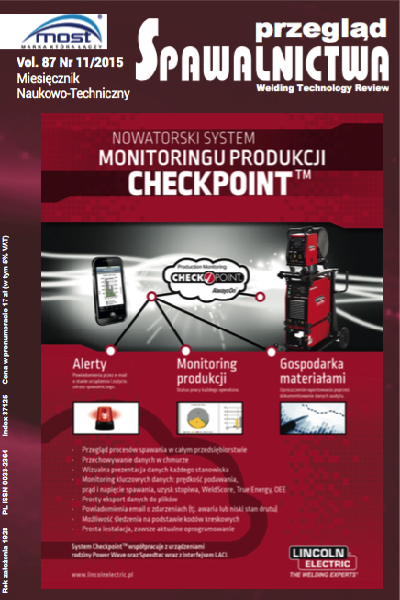Wpływ stopnia utlenienia proszku na właściwości mechaniczne powłok miedzianych naniesionych metodą LPCS
##plugins.themes.bootstrap3.article.main##
Abstrakt
W metodzie niskociśnieniowego natryskiwania zimnym gazem (z ang. Low Pressure Cold Spraying - LPCS) powłoka konstytuowana jest z proszku pozostającego w stanie stałym. Połączenie cząstek następuje poprzez dynamiczne odkształcenie materiału i ma charakter przede wszystkim mechanicznego zakleszczania. W wyniku silnego odkształcenia plastycznego cząstek oraz podłoża skorupa tlenkowa zostaje rozkruszona i usunięta z powstającą wypływką. Dlatego aby doszło do połączenia metali o czystej powierzchni, niezbędne jest usunięcie warstwy tlenków. Artykuł przedstawia wpływ stopnia utlenienia proszku miedzianego o morfologii dendrytycznej na właściwości mechaniczne powłok (przyczepność, twardość, moduł Younga) naniesionych metodą LPCS na podłoże stopu aluminium AW1350. Powłoki naniesiono przy użyciu dwóch komercyjnych proszków dendrytycznych o granulacji -40+15 μm. Stopień utlenienia proszków określono poprzez mikroanalizę rentgenowską EDX. Analizę mikrostruktury przeprowadzono przy zastosowaniu mikroskopii skaningowej (SEM) oraz świetlnej. Przyczepność powłok określono metodą odrywania, natomiast twardość metodą Vickersa przy obciążeniu 2,94 N. Wraz ze wzrostem utlenienia proszku zwiększyła się porowatość naniesionych powłok, która lokalnie docho- dziła do 12%. Przekłada się to na niskie właściwości mechaniczne, twardość rzędu 66 HV0,3 oraz wytrzymałość 3 MPa. Proszek o mniejszym stopniu utlenienia pozwolił nanieść powłoki o wyższej twardości 84 HV0,3 oraz wytrzymałości 5,5 MPa.
The influence of powder oxidation on mechanical properties of copper coatings deposited by LPCS method
Abstract
Low-pressure cold spraying (LPCS) method is a solid-state particle deposition process. Particles bond mechanism is due to material dynamic plastic deformation and take a form of mechanical interlocking. As a result of particles and substrate plastic deformation oxide layer is crushed and removed with creating material jet. Therefore metallic bonding occurs after oxide layer removal. Presented paper shows the influence of copper powder oxidation of dendritic morphology on mechanical properties of the coatings (bond strength, hardness, Youngs modulus) deposited by LPCS method onto AW1350 aluminium alloy. The coatings were deposited of two various commercially available dendritic powders with the particles size of -40+15 μm. Powders particles oxidation was determined with EDX analysis. SEM and OM was employed to analyse microstructure of the coatings. Moreover the coatings bond strength was measured with pull- off test and hardness with Vickers method using load of 2,94 N. The coatings porosity increased with increasing powder oxidation and amounted up to 12%. As a result low mechanical properties, e.g. hardness of 66 HV0.3 and bond strength of 3 MPa, were obtained. The coatings deposited of powder with lower oxidation showed higher hardness and bond strength, amounted to 84 HV0.3 and 5.5 MPa, respectively.
Pobrania
##plugins.themes.bootstrap3.article.details##
Creative Commons CC BY 4.0 https://creativecommons.org/licenses/by/4.0/
Artykuły czasopisma Welding Technology Review (Przegląd Spawalnictwa) publikowane są w otwartym dostępie na licencji CC BY (licencja Creative Commons Uznanie autorstwa 4.0 Międzynarodowe). Licencja CC BY jest najbardziej otwartą dostępną licencją i uważaną za „złoty standard” w formule otwartego dostępu; jest również preferowany przez wielu fundatorów badań. Licencja ta umożliwia czytelnikom kopiowanie i redystrybucję materiału na dowolnym nośniku i w dowolnym formacie, a także zmienianie, przekształcanie lub budowanie na nim materiału, w tym do użytku komercyjnego, pod warunkiem wskazania oryginalnego autora.
Bibliografia
Champagne V., The Cold Spray Materials Deposition Process: Fundamentals and Applications, Woodhead Publishing Ltd., Cambridge, 2007.
Maev R. G., Leshchynsky V., Introduction to Low Pressure Gas Dynamic Spray, WILEY-VCH Verlag GmbH & Co. KGaA, Weinheim, 2008.
Papyrin A., Cold Spray Technology, Elsevier, Oxford, 2007.
Maev R., Leshchynsky V., Air Gas Dynamic Spraying of Powder Mixtures: Theory and Application, Journal of Thermal Spray Technology, vol. 15, 2006, s. 198-205.
Wright T. W., Shear Band Susceptibility: Work Hardening Materials,
International Journal of Plasticity, vol. 8, 1992, s. 583602.
Wright T. W., Toward A Defect Invariant Basis For Susceptibility To Adiabatic Shear Bands, Mechanics of Materials, vol. 17, 1994,
s. 215222.
Schoenfeld S. E., Wright T. W., A Failure Criterion Based On Material Instability, International Journal of Solids and Structures, vol. 40, 2003, s. 30212037.
Kumar S., Bae G., Lee Ch., Deposition characteristics of copper particles on roughened substrates through kinetic spraying, Applied Surface Science, vol. 255, 2009, s. 34723479.
Guetta S., Berger M. H., Borit F., Guipont V., Jeandin M., Boustie M.,
Ichikawa Y., Sakaguchi K., Ogawa K., Influence of Particle Velocity on Adhesion of Cold-Sprayed Splats, Journal of Thermal Spray Technology, Vol. 18, 2009, s. 331-342.
Van Steenkiste T., Smith J., Teets R., Aluminum Coatings via Kinetic Spray with Relatively Large Powder Particles, Surface and Coatings Technology, vol. 154, 2002, s. 237-252.
Sudharshan Phani P., Srinivasa Rao D., Joshl S., Sundararajan G., Effect of Process Parameters and Heat Treatments on Properties of Cold Sprayed Copper Coatings, Journal of Thermal Spray Technology, vol. 16, 2007, s. 425-434.
Borchers C., Gärtner F., Stoltenhoff T., Assadi H., Kreye H., Microstructural and Macroscopic Properties of Cold Sprayed Copper Coatings, Journal of Applied Physics, vol. 93, 2003, s. 10064-10070.
Yin S., Wang X., Suo X., Liao H., Guo Z., Li W., Coddet Ch., Deposition behavior of thermally softened copper particles in cold spraying, Acta Materialia, vol. 61, 2013, s. 51055118.
King P.C., Bae G., Zahiri S.H., Jahedi M., Lee Ch., An Experimentaland Finite Element Study of Cold Spray Copper Impact onto Two Aluminum Substrates, Journal of Thermal Spray Technology, vol. 19, 2010, s. 620-634.
Calvo F. A., Ureng A., Gomez De Salazar J. M., Molleda F., Special features of the formation of the diffusion bonded joints between copper and aluminium, Journal of Materials Science, Vol. 23, 1988, s. 2273- 2280.
Norma PN-EN 582:2006 Natryskiwanie cieplne. Określanie przyczepności metodą odrywania, Polski Komitet Normalizacyjny.
